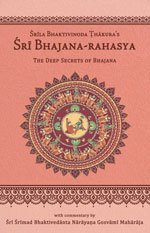Bhajana-Rahasya
by Srila Bhaktivinoda Thakura Mahasaya | 2010 | 123,965 words
The Bhajana-rahasya Text 23, English translation, including commentary (vritti). The Bhajana-rahasya is a compilation of verses describing the mercy of the eight pairs of names (Yugala-nama) of the Maha-mantra. This is text 23 belonging to the chapter “Ashtama-yama-sadhana (Ratri-lila–prema-bhajana sambhoga)” representing from midnight to three-and-a-half praharas of the night: approximately 00.00 a.m.–3.30 a.m.
Text 23
Śrī Gīta-govinda (1.48) describes the ecstasy of the rāsa dance, the eternal rāsa-vilāsa of Śrī Kṛṣṇa and the vraja-sundarīs:
विश्वेषाम् अनुरञ्जनेन जनयन्न् आनन्दम् इन्दीवर-
श्रेणी-श्यामल-कोमलैर् उपनयन्न् अङ्गैर् अनङ्गोत्सवम्
स्वच्छन्दं व्रज-सुन्दरीभिर् अभितः प्रत्य्-अङ्गम् आलिङ्गितः
शृङ्गारः सखि मूर्तिमान् इव मधौ मुग्धो हरिः क्रीडतिviśveṣām anurañjanena janayann ānandam indīvara-
śreṇī-śyāmala-komalair upanayann aṅgair anaṅgotsavam
svacchandaṃ vraja-sundarībhir abhitaḥ praty-aṅgam āliṅgitaḥ
śṛṅgāraḥ sakhi mūrtimān iva madhau mugdho hariḥ krīḍatiO sakhī, He who gives pleasure and bliss to all the gopīs, whose limbs are bluish-black, very soft and resemble blue lotuses, whose qualities awaken the festival of Kandarpa (Cupid) that lies dormant within the gopīs’ hearts, and who is embraced by each and every limb of the gopīs–that Kṛṣṇa is sporting like amorous love personified in the spring season.
मधु-ऋतु मधुकर-पाङ्ति
मधुर कुसुम मधु-मातिmadhu-ṛtu madhukara-pāṅti
madhura kusuma madhu-mātiमधुर वृन्दावन माझ
मधुर-मधुर रस-राजmadhura vṛndāvana mājha
madhura-madhura rasa-rājaमधुर-नटिनी-गण-सङ्ग
मधुर-मधुर रस-रङ्गmadhura-naṭinī-gaṇa-saṅga
madhura-madhura rasa-raṅgaसुमधुर यन्त्र-रसाल
मधुर-मधुर करतालsumadhura yantra-rasāla
madhura-madhura karatālaमधुर-नटन-गति-भङ्ग
मधुर नटनी-नट-रङ्गmadhura-naṭana-gati-bhaṅga
madhura naṭanī-naṭa-raṅgaमधुर-मधुर रस-गान
मधुर विद्यापति भाणmadhura-madhura rasa-gāna
madhura vidyāpati bhāṇa
Commentary: Bhajana-rahasya-vṛtti:
The crown jewel of connoisseurs of mellows, dhīra-lalita-nāyaka Vrajendra-nandana Śrī Kṛṣṇacandra, appears as Kāmadeva personified and relishes śṛṅgāra-rasa with the vraja-devīs. One sakhī informs her friend that in a nearby forest of kuñjas, Śrī Kṛṣṇa is absorbed in amorous encounters (rāsa-vilāsa) with the young gopīs. She says, “Look sakhī, look! Just see how Kṛṣṇa, possessed by an eager desire for captivating amorous sports, is bound by the embraces of the young women of Vraja.” One goparamaṇī is lovingly embracing Śrī Kṛṣṇa and sweetly singing. Another gopī is pressing against Śrī Kṛṣṇa with her uplifted, hard breasts. One gopa-ramaṇī with heavy hips is blooming with prema. On the pretext of whispering into His ear, she fulfils her heartfelt wish by kissing Him. Śrī Kṛṣṇa is also increasing the love of the beautiful women of Vraja by embracing and kissing them and pleasing them with His smiling sidelong glances. Śrī Hari, not considering right or wrong, displays His charming pastimes with the gopa-ramaṇīs in the spring season. With His body, which is exquisitely soft like a dark blue lotus flower, He creates a great festival of Cupid by awarding the nectar longed for by the vraja-sundarīs. He is freely embracing and touching them, thus manifesting Himself as the personification of śṛṅgāra-rasa.
The word indīvara in this Text indicates ‘coolness’, the word śreṇī indicates ‘relishing ever-fresh mellows’, śyāmala indicates ‘beauty’ and komala indicates ‘extreme softness’.
